Dying candles with mica powder allows you to make truly unique homemade gifts that may look like a million bucks but cost only a few dollars.
Not only can you dye candle wax with mica powder, you can also paint the finished candles either free hand, or by using molds with intricate or raised designs.
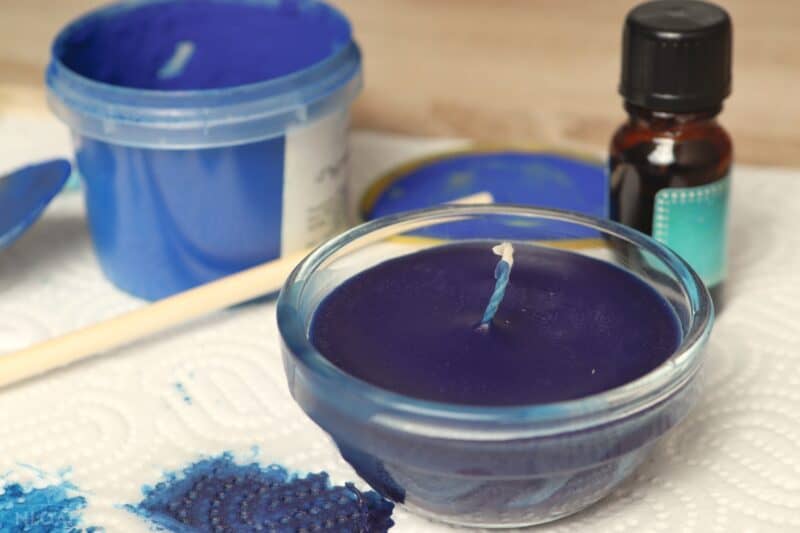
There are multiple ways to color or dye candles, but mica powder is my favorite. The wide array that mica powder comes in allows you to not just choose a color, as you can with colored candle wax blocks, but to pick from varying shades of a specific color – and even mix up your own hues.
What Is Mica Powder?
Mica powder is a white, slightly brown, yellow, or gray substance that comes from muscovite stone. The metamorphic rock that creates the mica also contains potassium aluminum silicate – which helps create the shimmery sparkling flakes in the mica powder.
It is a type of fine glittery material that dyes or colors nearly any surface it comes into contact with. In addition to coloring candles with mica powder, it is also often used to dye soap, cosmetics, and to paint of fabric, glass, and paper.
When left alone in its natural state, mica powder creates a dazzling sparkle to any candle or other project that it is used to adorn. But, when the mica powder is tinted and sold in art supply kits, you have every shade of every color under the sun at your creative disposal.
Can You Really Use Mica Powder in Candlemaking?
Yes. I’ve done it for years, and if you don’t take my word for it you should know that it has been used by countless manufacturers for decades to achieve spectacular colors, intriguing patterns and interesting textures in candles.
In fact, it has been used for a lot longer than that: Mica has been used in candle-making for ages!
There is some evidence that mica and other minerals were used by the ancient Egyptians to give their candles a more luxurious and decorative look, making them suited for use in religious ceremonies and other important events.
All the way through today, mica still has a place in commercial and home candle-making. It isn’t for everyone, but if you like the idea you should definitely try it. You can get it at pretty much any well-equipped candle supply retailer.
Is Adding Mica to Candles Safe?
Yes, adding mica to candles is safe. Some folks shy away from using mica powder for candles out of fear it can clog the wick or turn the pretty homemade candles into a sparkler.
I have used colored candles with mica powder for years, and have never had such an issue. But, the potential fire hazard and other hazards associated with mica is something that warrants discussion.
First, mica is non-toxic and its particles are heavy and unlikely to be inhaled. It also does not react negatively when burned or exposed to high heat, so no worries about releasing any harmful chemicals.
Even better, mica is easy to handle and can be used in almost any type of candle. Whether you’re making votives, tapers or pillars, you can use mica to create unique and beautiful candles safely.
Now, there is indeed a risk of mica clogging up the wick of a candle as it is burned continuously. This is because the mica flakes can be drawn into the wick with melted wax and, over time, impede the ability of wax to flow into it.
This usually shoes itself as a smaller and smaller flame over time that is easily put out, and a wick that is reluctant to light.
While this is an issue for candle performance, it is not really a safety hazard: the worst thing that happens is the candle just goes out. You don’t need to worry about mica causing your candle to combust, spark or anything like that.
Dying Candles With Mica Steps
Equipment
- Scissors
- Pencil or wood skewer
- Paintbrush
Ingredients
- Mica powder
- Candle wax pastilles or chunks
- Candle wicks pre-waxed are recommended
- Candle molds
- Wax melting equipment double boiler, microwave, dedicated crockpot
- rubbing alcohol 91% or higher (if you use more than one mica color)
- Transparent tape
- Essential oils, herbs, or other scent and adornment materials optional
Instructions
- Cut your wick to the desired height, and place it into the candle mold.
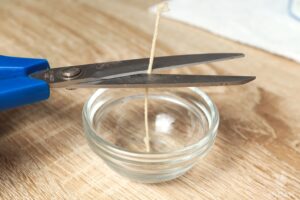
- Make sure the candle wick base is laying flat on the bottom of the mold. Tape it into place if necessary.
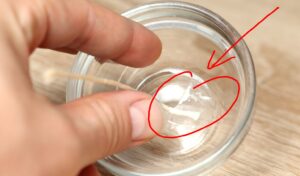
- Lay the pencil or wood skewer across the opening of the candle mold.
- Tape the wick to the pencil or wood skewer to hold it firmly in place and upright.
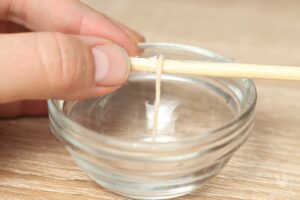
- Open the packets or jars of mica powders, and have them ready.
- Do this step only if you're mixing several colors of mica powder together to achieve customized color:Combine the dry powders with 1 drop of rubbing alcohol per every 3 teaspoons of powder, and stir thoroughly to combine.If the mixture is too dry to combine completely, add tiny bit more (less than one capful) of rubbing alcohol. If the mixture is running, carefully stir in a pinch more of the mica powder until a light gravy texture, and the color you desire, is achieved.
- Melt the candle wax as per the directions in your recipe, or the instructions on the package.
- Add either the mica powder or the mica powders mix into the melted wax.
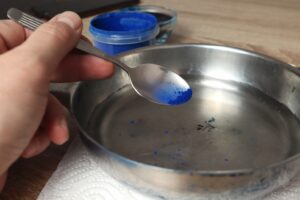
- Stir the mica powder (either dry flakes or the mixture of rubbing alcohol and mica powder) into the wax while it is in a hot liquid state and combine thoroughly.
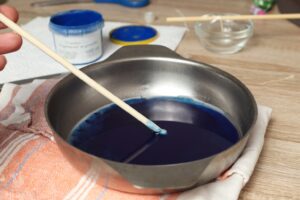
- Add in any scented oil, herbs, or other adornments guided by your recipe instructions.
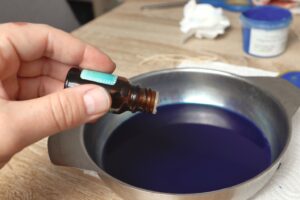
- Pour the candle mixture into your molds.
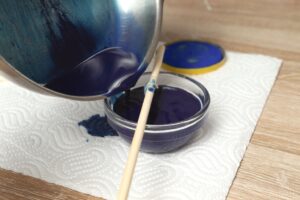
- Use the pencil to continue to stir the mixture inside the candle mold as it's starting to harden. This is to ensure the mica spreads evenly and won't clog the wick as it burns.
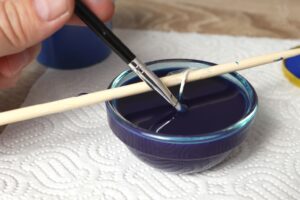
- Allow the mixture to cool off.
Once the candles have hardened and have been removed from the molds, you can paint a decoration or raised part of the mold design with mica powder.
The mica powder works best as a paint when mixed with rubbing alcohol as noted above to make a spreadable paint to use on candles and other materials, in my personal experience.
Some folks choose to mix the mica powder with distilled water or even into a little bit of standard school glue instead, when using it in paint form.
I have used mica powder to dye both beeswax and soy way candles. If using beeswax, make sure to purchase it in white and not the typical yellow, even if you will be dying the candles a dark color.
For reasons I have yet to understand, mica powder tends to work best when used with soy wax.
All natural homemade wax melts can also be dyed or painted with mica powder, by following the directions noted above.

Tara lives on a 56 acres farm in the Appalachian Mountains, where she faces homesteading and farming challenges every single day, raising chickens, goats, horses, and tons of vegetables. She’s an expert in all sorts of homesteading skills such as hide tanning, doll making, tree tapping, and many more.

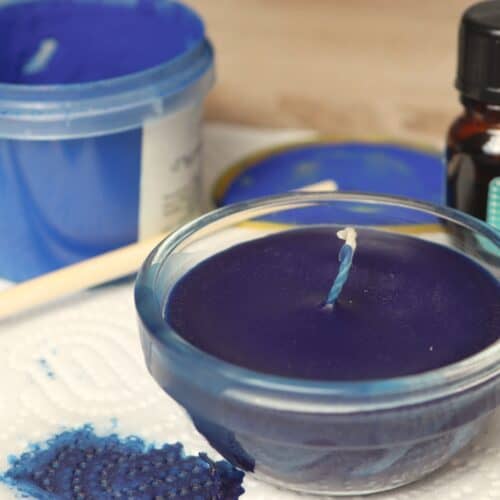
Ya’ll are just mad you aren’t making pretty candles too
I just started canceling with the Micah powder. I love it! How come it all sinks to the bottom?? It loses all color and it clogs my cotton and wood wicks!! I need help!
You put too much in it. And you may need a better quality wick as well. That was one of my problems when I began making candles. I now use Eco wicks for soy candles, hemp wicks and wooden wicks. I use vegan wax for color combined with the mica powder. I watch the amount of mica that I put into the candle.
Nobody should be putting dry herbs or adornments into their candles unless they want to play Russian Roulette with theirs or others lives!
Settle down Deedee, candles are meant to be burned, they’re already on fire and inherently dangerous. You’re starting a tiny fire in your house… You have to be smart about it either way. Burning a candle with dried herbs is just as dangerous as burning a candle in general.
I have been making candles for quite a long time and its a very flourishing business. And I’m sorry to say but 99% of my candles have Stones, Herbs & flowers in the top. Or the tapers have been Rolled in herbs or some have them going down them which are called “loaded” candles when made properly, and burned safely they are perfectly fine and absolutely beautiful candles. Do not comment on what you do not know of. K thanks.
I am sure that as the owner of a flourishing candle business, you are properly insured and follow all rules set forth by the National Candle Association including international ASTM standards, and are even further comfortable with – if not the increased fire risk – increased smoke and release of carcinogens in the air. I’m sure you’re also comfortable with the risk of cracking, splintering, and exploding that comes with crystals as well. Merry Making!
You are absolutely right, DeeDee. Crack on!